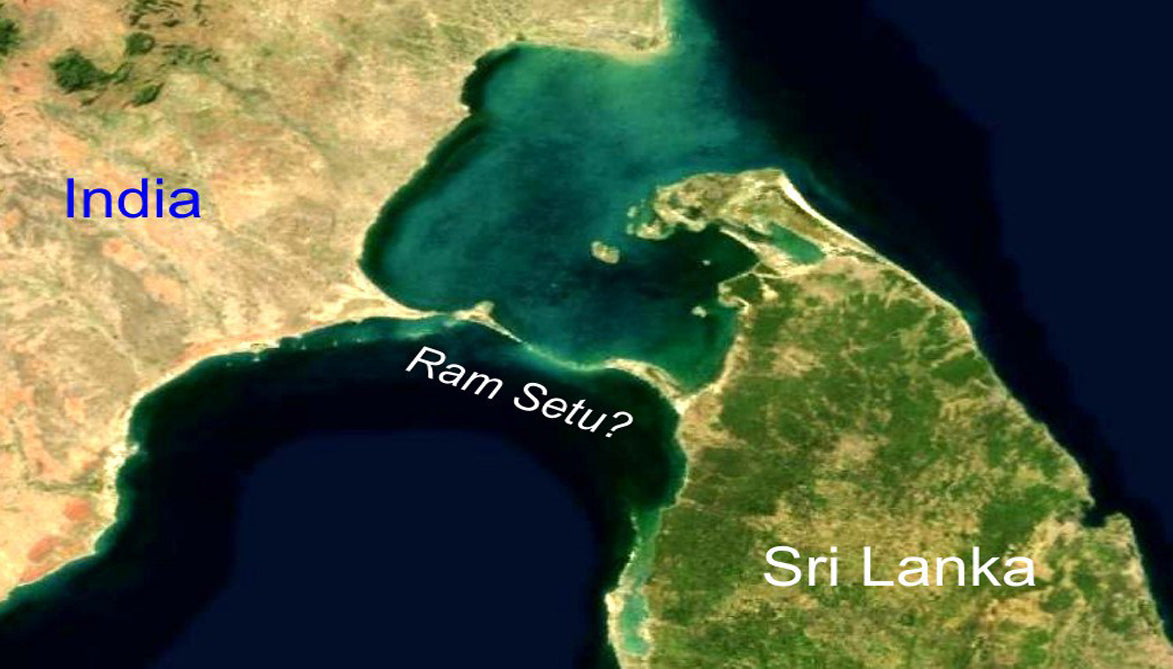
Ram Setu – A hope to bridge the divide
What is Ram Setu?
Ram Sethu is a continuous stretch of limestone shoals running from Pamban island near Rameshwaram, Tamil Nadu, India, to Mannar Island on the Northern Coast of Sri Lanka. Known also as Adam’s Bridge, it is believed to be the breaking away of a certain land mass that has created the separation of Sri Lanka from the Indian land mass. Hindu sentiment has it that the structure is what Lord Rama and his army of monkeys built to reach Sri Lanka to invade it and free Goddess Sita from the clutches of Ravana, the demon king.
Raising dust about the Ram Setu
In the stretch occupied by the submerged Ram Setu, the depth of the sea is anywhere between 3 ft. and 30 ft., thus making navigation impossible in the present condition. The ships bound for the Eastern Coast of India have to circle the entire island of Sri Lanka to reach the ports of Tuticorin, Chennai, Vizag, Paradip and others. Naturally this means travelling 350 nautical miles additionally and 30 hours of shipping time.

Proposal by the then Government
There was a study initiated by the then government in the early 90s to study the feasibility of creating a navigable route along the said path that would cut the time and costs for ships to reach the eastern coast. The project titled the Sethusamudram Shipping Canal Project was mooted by the Government of India and despite deciding to go ahead in 1997, nothing concrete came about till 2005. The plan that was finalized meant for 13 minor ports in India and fishing harbours and other infrastructure to be developed along the coastline in both India and Sri Lanka shores.
The project involves creating an 83 Km long deepwater channel to link Mannar with Palk Strait by extensive dredging that would mean removal of the Ram Sethu limestone shoals.
Fierce Opposition from the general public
This proposal met with widespread anger and resentment in the minds of the general public. There came into existence a Save Ram Sethu Campaign in 2007.
There were two schools of thought.
- one that felt that the tampering with the Ram Sethu was akin to destroying a sacred heritage that had religious feeling and sentiment attached to it with the minds of thousands of Hindus.
- one that felt the ecology and environment would be in peril and would be destroying a thriving flora and fauna of that place. Economic gains as anticipated by the government was misplaced thinking they said as the waters which would have more of overseas ships from the African or European coasts (65 % of total ships) would hardly have any gain by way of time saving. There would also be restriction of loading or tonnage of ships that could be navigable and most ships that would make use of the route would be beyond the allowed capacity.
This apart even the Sureme Court based on a PIL asked the government then to put on hold its plans.

Recent status of the project
The present government on August 2014 came up with 4 alternatives to not only get the controversial Sethusamudram Shipping Canal Project see the light of the day, but also without creating any damage to the existing Ram Sethu that is so dear to popular Hindu sentiment.
A new and shorter route than that suggested by the Supreme Court which also had been suggested by the R.K.Pachauri committee earlier would not involve dismantling the existing Ram Sethu bridge. This had been disagreed upon by the then UPA Govt when the committee had suggested it. This has been the latest in proposals and one that even the vast Hindu populace would go along with.
A new line of thought threatening to destroy existing belief
While this is raging and a decision to implement is close at hand, there is a fresh controversy raked up by certain individuals and groups that see the Ram Setu as a myth or a certain propagation of thought that has no basis of truth. In other words these people consider the Ram Sethu to be man-made and have furnished some fallacious reasoning that could upset the dogged Hindu fanatic and create doubt in the minds of the logical Hindu who is suddenly wondering which is right – Ram Sethu, an actual bridge that has been created by Lord Rama and the army of monkeys or a man-made bridge that demolishes all beliefs held true till now and wants that the dredging be carried out and the deep water route become a reality?

A new line of thinking needed
Based on the above facts a fresh line of thinking regarding the Ram Setu needs to evolve. This would not only augur well for popular public sentiment but also serve the very purpose for which the discussion has been initiated.
- The finding that the anticipated benefits from the efforts and results of the dredging would not be commensurate, as in this case, is itself thought provoking to push for deeper study in the matter before coming to a conclusion.
- Like lawyer and MP Subramaniam Swamy had suggested, the Ram Sethu should be declared a national monument and protected like a national monument deserves to be. This protects it from hasty decisions that could destroy the Sethu and create damage that cannot be undone and at the same time rake up unnecessary rage and unhealthy emotions to spark into a national outrage.

- Once declared that, some research organization backed by government funding can find out more on the Ram Sethu and enlighten an eager Indian public what exactly is the Sethu and its significance once and for all. This would also address the suggestion made that it is a man-made construction that would either hold water or fall flat and settle the issue.
- The recent suggestions of the current government if are actually not going to do any harm to the Sethu and if the navigable way is made possible it would set countless minds at rest and achieve the much needed solution.
- There may be controversy surrounding any structure, and as long as there is no real loss in an existing situation that has maintained over thousands of years, hurry in finding a solution just to prove a point would not only be foolhardy but highly risk prone and irreversible as well. Under such circumstances, a relevant study group properly funded and given the ambit of probing sufficiently deep should serve the purpose.
- Many countries of the world have protected centuries old structures just to preserve them for posterity and the historical value of a rare heritage that would be the pride of a nation. How can India be so very casual amounting to almost callousness if it were to take the Ram Sethu issue so very lightly?
One may say many a thing about the Ram Sethu, in its favour or against, but when a belief that has existed thousands of years in the minds of countless devotees, and it does not really come much in the way of a perceived benefit economically, it is better to seek other solutions that allow the sentiment to remain and at the same time provide the needed relief that is sought, sooner or later.
[/vc_column_text][/vc_column][/vc_row]


















































